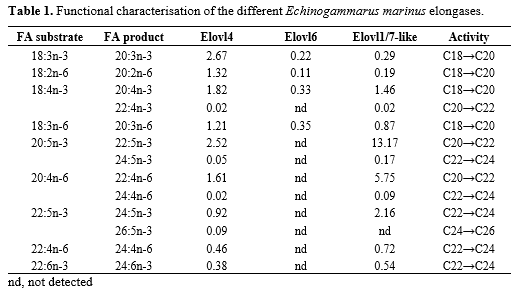INVESTIGATING THE BIOSYNTHESIS OF LONG-CHAIN POLYUNSATURATED FATTY ACIDS IN MARINE GAMMARIDS
Introduction
Gammarids are aquatic invertebrates that have been identified as promising candidates for their use in aquaculture. Gammarids have good growth performance, tolerate high densities and, importantly, can be fed on a wide range of sidestreams from bioindustries
. While marine gammarids contain relatively high levels of long-chain (C20–24) polyunsaturated fatty acids (LC-PUFAs), physiologically essential compounds required for normal growth and development of vertebrates
, it is unknown whether the LC-PUFA levels of gammarids grown on low LC-PUFA containing substrates can be maintained . Conversions of short-chain fatty acids (FAs) into LC-PUFAs in animals is determined by the complement and function of genes encoding enzymes that catalyse these multistep pathways
. Our main goal is to elucidate the LC-PUFA biosynthetic pathways in gammarids in order to identify species with high capacity to convert short-chain FAs available in sidestreams into LC-PUFAs that ultimately could allow obtaining a high nutritional value biomass . Specifically, this study aimed to characterise molecularly and functionally three genes encoding elongation of very long-chain fatty acid (Elovl) proteins , termed as elovl4 , elovl6 and elovl1/7-like, from Echinogammarus marinus .
Materials and methods
To obtain the full-length sequences of the E. marinus elovl4 , elovl6 and elovl1/7-like open reading frames (ORFs) , BLAST searches were carried out on the Transcriptome Shotgun Assembly (TSA) of the Gammarus BioProject (PRJNA497972) . The ORFs were identified and then isolated by PCR using E. marinus complementary DNA (cDNA) as template, with primers containing specific restriction sites for further cloning into the pYES2 vector. The E. marinus Elovl4, Elovl6 and Elovl1/7-like were functionally characteris ed by heterologous expression in yeast. Transgenic yeast containing the different E. marinus elovl ORFs were grown in the presence of a series of exogenously supplemented polyunsaturated fatty acid (PUFA) substrates to test their elongation capacity. After 2 day incubations, yeast were harvested and washed prior extraction of total lipids. An aliquot of total lipids was used to prepare fatty acid methyl esters for analysis by gas chromatography. Conversions of PUFA substrates to the corresponding products were calculated by the proportion of substrate FA converted to elongated FA product(s) as [areas of all products with longer chain than substrate/(areas of all products with longer chain than substrate + substrate area)] × 100.
Results
The molecular analyses showed that all the E. marinus Elovl sequences had the distinctive characteristics of fatty acyl elongases , including a h istidine box (HXXHH) . Interestingly , Elovl4 and Elovl1/7-like, but not Elovl6, contained diagnostic amino acids preceding the histidine box that are characteristic of PUFA elongases . Consistently, the functional characterisation results showed that the E. marinus Elovl4 and Elovl1/7-like are indeed PUFA elongases, since they elongated PUFA substrates ranging from C18 to C22 . However, the E. marinus Elovl6 only showed activities towards C18 PUFA substrates (Table 1).
Discussion and conclusions
The research described in this work demonstrates that gammarids possess at least three distinct elovl genes, namely elovl4 , elovl6 and elovl1/7 -like, with putative roles in the biosynthesis of LC-PUFAs. Molecular and functional characterisation of the set of elovl sequences from the marine gammarid E. marinus revealed that gammarids’ Elovl4 and Elovl1/7-like are PUFA elongases with affinity towards PUFA substrates ranging from C18 to C22, and account, by themselves, for all the elongation reactions required for LC-PUFA biosynthesis from C18 biosynthetic precursors
. On the contrary, the gammarid Elovl6 sequence contained characteristics typically found in non-PUFA elongases
that, along with its elongation capacity being restricted to C18 PUFA substrates, indicated that this enzyme does not play major roles in LC-PUFA biosynthesis in gammarids. Elovl4 was the sole Elovl found in gammarids with the ability to produce PUFAs of up to 26 carbons. Overall, the present study provides insight into the endogenous machinery enabling gammarids to bioconvert dietary fatty acids into high value LC-PUFAs.
References
1. Alberts-Hubatsch, H.; Slater, M.J.; Beermann, J. Effect of diet on growth, survival and fatty acid profile of marine amphipods: Implications for utilisation as a feed ingredient for sustainable aquaculture. Aquac. Environ. Interact. 2019, 11, 481–49.
2. Jiménez-Prada, P.; Hachero-Cruzado, I.; Guerra-García, J.M. Aquaculture waste as food for amphipods: the case of Gammarus insensibilis in marsh ponds from southern Spain. Aquac. Int. 2021, 29, 139-153.
3. Guillou, H.; Zadravec, D.; Martin, P.G.P.; Jacobsson, A. The key roles of elongases and desaturases in mammalian fatty acid metabolism: Insights from transgenic mice. Prog. Lipid Res. 2010, 49, 186–199.
4. Gladyshev, M.I.; Sushchik, N.N.; Makhutova, O.N. Production of EPA and DHA in aquatic ecosystems and their transfer to the land. Prostaglandins Other Lipid Mediat. 2013, 107, 117–126.
5. Monroig, Ó.; Kabeya, N. Desaturases and elongases involved in polyunsaturated fatty acid biosynthesis in aquatic invertebrates: a comprehensive review. Fish. Sci. 2018, 84, 911–928.
6. Hashimoto, K.; Yoshizawa, A.C.; Okuda, S.; Kuma, K.; Goto, S.; Kanehisa, M. The repertoire of desaturases and elongases reveals fatty acid variations in 56 eukaryotic genomes. J. Lipid Res. 2008, 49, 183–191.
